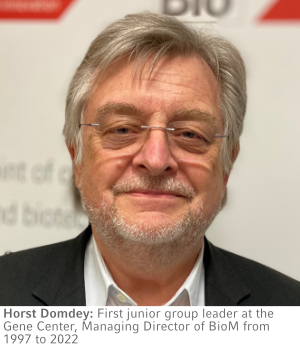1984 - 1997: Horst Domdey - 1st junior group leader
Being the first recruited junior group leader
It was in late 1983, when I was working as a postdoctoral fellow at the California Institute of Technology in Pasadena, California, that I heard for the first time of the planned creation of a new life science research program in Munich, the Munich Gene Center. Looking back, I have to say that I was very fortunate to accept Prof. Ernst-Ludwig Winnacker's invitation to join the newly founded endeavour as a junior group leader in June 1984. Together with 7 other junior scientists who led comparable research teams, I was accommodated at the Max Planck Institute for Biochemistry in Martinsried. That was absolutely exciting – today you would say awesome.
Being the first recruited junior group leader, I was given the task of furnishing the empty laboratories with the necessary equipment, starting from pencils up to ultracentrifuges. A similar fate actually befell me in the early 1990s, when it was decided to build a completely new facility for the Munich Gene Center on the campus Großhadern, next to the LMU University Hospital. Together with a colleague, I accompanied the planning of this new institute and its implementation almost every day until 1994. Unfortunately, this resulted in a complete publication gap in 1993, which was, fortunately, compensated for by an increased number of publications of my group in 1994.
First spin-offs from the Gene Center
At the beginning of the 1990s, some of the first local biotechnology companies were founded as spin-offs from the Munich Gene Center: Micromet, MorphoSys and Medigene. They all had a strong focus on the development of therapeutics. (Mikrogene, a diagnostic firm and the oldest Munich biotech company, had already been spun off the Munich Pettenkofer Institute in 1989.) An important factor for this special and unprecedented development was certainly the year-long financial support which the Gene Center had received since its conception, particularly from Hoechst AG, but also from Wacker Chemie and Boehringer Mannheim. Perhaps precisely because the Gene Center had hardly any obligations towards its industrial sponsors at the time, any fears of contact with the industry were quickly overcome. Due to the contact with the sponsors, scientific collaborations were started, too, and became established. This very unbureaucratic and more or less obligation-free industry support of our academic scientific work had certainly a very strong positive influence on the opening of science to the commercial sector of the life sciences.

Munich Gene Center as birthplace of the Munich Biotech Cluster
In this way, the Munich Gene Center all of a sudden became the birthplace of the Munich Biotech Cluster. The rapid development of the Munich BioTech Region – as it was called in those days – was also supported by winning the BioRegio competition of the Federal Ministry of Research and Technology (BMFT) in 1996. Together with Ronald Mertz, a former member of Ernst-Ludwig Winnacker's research group, who was then working in the Bavarian Ministry of Economic Affairs, I was able to complete the application for this award just on time (at 3 a.m. on the final date), and all application documents – including 10 Leitz folders of supporting material – were sent by a private car to the Projektträger Jülich. A few weeks later, Ernst-Ludwig Winnacker presented the concept, the goals and the underlying strategy of our application to the Federal Ministry of Research. The title of his presentation was “Munich’s Innovation Culture in the Life Sciences”. In November 1996, Munich was eventually elected as one of the three winning “BioRegions” alongside Heidelberg and the Rhineland. To our great surprise, this distinction as a “Model Region for Biotechnology” was accompanied by a strong financial funding commitment from the BMFT totalling 50 million DM. In the following months, these millions were distributed exclusively to those biotech start-ups, which were able to co-finance such a grant with the same amount of private money.
In 1997, Ernst-Ludwig Winnacker decided to become President of the DFG and leave Munich for Bonn, and I also swapped my professorship at the Institute of Biochemistry for the newly founded BioM AG, whose aim was the creation of the Munich Biotech Cluster with its center in Martinsried. Thanks to the very dynamic local start-up scene, this venture was extremely successful and Munich developed into one of the most prosperous biotech clusters in Europe.

